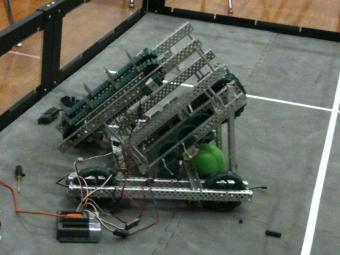VEX Nothing But Net
Robotics //
The challenge for my third year doing VEX Robotics was Nothing But Net. This challenge had robots shooting foam balls into their team's net in the corner of the field. Unlike the last two challenges, robots were significantly restricted in how much they could expand during the match. This made it much harder to get the bonus points awarded for lifting your teammates robot above the field perimeter. Now that the previous senior team had graduated, my friend and I were now the most experienced students there.
Our robot was designed to intake the foam balls on one side, and then spit them out the other side using a flywheel. We had seen similar robots online before, and those robots had been quite successful. There was a design for a potential bot-lifter, but it never got built due to time restrictions and repeated problems with the other parts of the bot.
Intake: To intake the balls we used a series of rollers with tank tread and rubber flaps, and this system would take the balls all the way to the flywheel. For the first few competitions the intake was only a few inches wider than the balls themselves, but for the provincial championship we widened the intake so that it could pick up two balls simultaneously.
Drive: Like the last two years, we dedicated four motors to the drive system, and we went back to using the Omni wheels that we has used in our first year. However, when we increased the size of the intake we needed to move the motors, so we moved those two wheels into the middle of the bot. This increased the robot's ability to turn quickly, and we fixed any tipping issues by placing another set of wheels farther out that were just slightly above the ground.
Flywheel: The flywheel was the core part of the robot, and had most of the robot designed around it. It was powered by six motors, and was geared up several times. The flywheel itself had several iterations, and was made using a variety of different parts. The final edition of the flywheel was made from the cores of two high-friction wheels with plastic tread around them, and then a layer of rubber bands around that. Initially we thought that it would be better for the flywheel to have a high mass so that it would have more inertia, but as the game season progressed it turned out that having a lighter flywheel that can be quickly powered up was superior.
During this year we did not win any tournaments, and our skills score was lacking compared to the epic scores that some teams were achieving. However, we did have some triumphant underdog moments at our final two tournaments. One of these was in the quarter-finals of the provincial championship; we were the third pick of the eighth alliance, and our flywheel's sensor were broken, but the robot's ability to work as a push bot was successful enough to beat the first-place alliance. This year was not my best year, but I learned more about how much work it takes to build a highly competitive robot.
